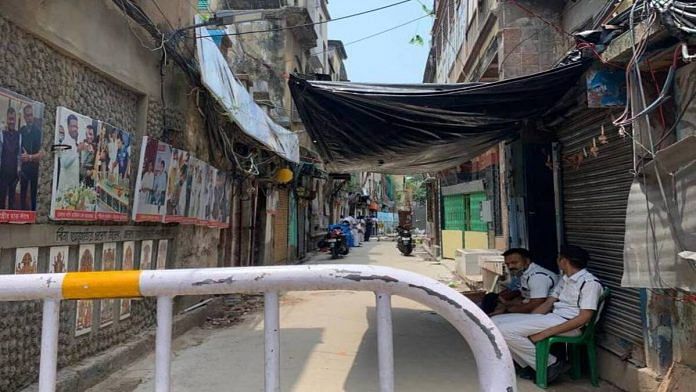Kolkata: The historic jewellery hub of Bowbazar in Kolkata may be in for big changes. An expert committee from Jadavpur University has recommended that 45 homes, all nearly two centuries old, should be demolished after cracks appeared in many of the neighbourhood’s buildings due to underground construction work on the Kolkata Metro.
Already, 26 homes in Bowbazar have been pulled down for safety reasons by the Kolkata Metro Rail Corporation Limited (KMRCL) — 23 in September 2019 and three others in May this year. If the 45 other buildings are razed as recommended, the total will go up to 71.
The expert committee, comprising retired and serving civil engineering professors, was commissioned in May by the Kolkata Municipal Corporation (KMC) to assess the damage to the buildings and to outline solutions.
The committee’s 80-page report, which ThePrint has seen, was submitted in the second week of October and says there are three ways to accommodate displaced residents and rebuild the neighbourhood.
One way is for the KMC and the Kolkata Metro to develop a modern jewellery centre along with residential high-rises to replace the old houses, all of which are 185 years old or even older. Alternatively, the razed houses could be rebuilt after relaxing building rules, but this, adds the report, wouldn’be cost-effective. The third option is for the neighbourhood to have a mix of high-rises and two- to three-storey houses, all freshly built.
Safety issues have beleaguered congested Bowbazar ever since work began to build the East-West metro corridor, which will include India’s first underwater metro tunnel.
In September 2019, two buildings collapsed and several others developed cracks, leading to a delay in the project. In May 2022, similar issues arose again and more than 150 residents of Durga Pithuri Lane had to be moved out for safety reasons. Work stalled for months, but a week after grouting activities resumed in October, cracks were reported again.
ThePrint has contacted KMC commissioner Binod Kumar through text, WhatsApp, calls, and email for his comments on the report; this article will be updated once a response is received. Deputy mayor Atin Ghosh said the matter was outside his domain and to speak to the KMC commissioner regarding the report.
Kolkata Metro director (project) N.C. Karmali told ThePrint that the report from the expert panel hadn’t yet been received from the KMC. He added that work below Bowbazar has been stopped.
Meanwhile, many residents of Bowbazar continue to live in uncertainty, with those who were evacuated this month still lodged in hotels.
“We will shortly begin the compensation process for the residents of Madan Dutta Lane who were displaced on 14 October,” Karmali added.
Also read: 100 years in the making, why Kolkata’s east-west corridor is world’s slowest metro project
What the expert committee has found
Speaking to ThePrint, expert panel member Himadri Guha, a retired professor from Jadavpur University, said that the team had been constituted by the KMC in May this year to survey houses and shops in Bowbazar after the Durga Pithuri Lane incidents.
“We were about to submit our report when a second instance was reported from Madan Dutta Lane in the second week of October, and we then had to expand the scope of our survey and submit a report to the KMC urgently,” he said.
The report highlights that there have been five instances since 2019 where buildings in Bowbazar developed cracks due to metro construction work. However, there hasn’t been any major tunneling work after September 2019, where the issues with buildings were attributed to the tunnel borer hitting the aquifer— the underground layer of water-bearing rock/sediments. This had reportedly resulted in ground subsidence, or sinking, leading to the cracks and some houses caving in.
The JU panel’s report references archival materials, including British geographer James Rennell’s 1794 map of Bengal, to pinpoint the cause of the building issues in Bowbazar.
“Calcutta is one of the most well-documented cities in the world. Since it was the British capital, the maps have the greatest details. Bowbazar had a creek, it was a wetland. In 1709, the British constructed a road as per the East India Company minutes in the archives. There is an aquifer below Bowbazar, which means the rock below the soil that holds water,” Guha explained.
Kolkata Metro’s Karmali told ThePrint that activities are on in the East-West corridor, but the cross-passage work below Bowbazar has been halted. “Our expert teams are surveying and inspecting the zone. Stup Consultants are our building expert partner, and they are also studying the buildings in the area,” he added.
(Edited by Asavari Singh)
Also read: Delhi said no but Mamata got Kolkata Metro to change route — now houses are collapsing



